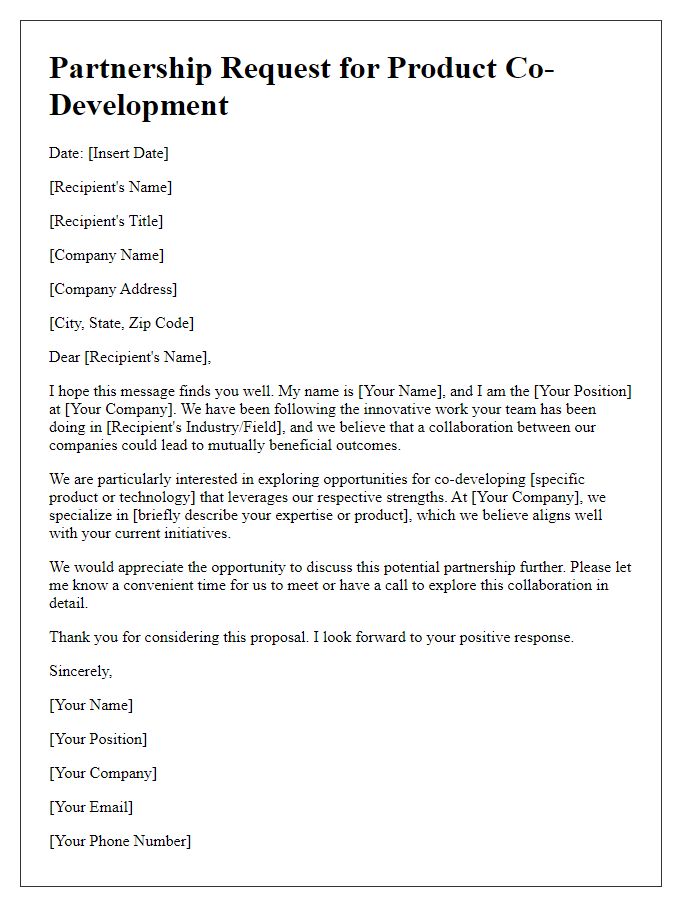In today's fast-paced market, forging strategic partnerships can be a game-changer for innovation and growth. By collaborating on product co-development, businesses can leverage shared expertise and resources to create offerings that truly resonate with consumers. Imagine the potential of combining strengths, where each party contributes unique insights and skills to achieve a common goal. If you're curious to discover how such partnerships can elevate your brand, keep reading!

Clear objectives and goals
Collaborative product development involves defining clear objectives and goals to ensure that partners like Tech Innovations Inc. and Eco Solutions Ltd. align their efforts effectively. Establishing measurable targets such as a 20% reduction in production costs within 12 months or a 30% increase in market reach by the end of the second quarter is crucial. Milestones, like the completion of prototyping by March 2024 or obtaining necessary regulatory approvals by July 2024, should be documented. Resource allocation, including budgetary commitments (like a joint investment of $500,000), personnel responsibilities, and timelines, must be outlined to prevent miscommunication and facilitate accountability. Regular progress reviews scheduled bi-monthly can help maintain momentum and adjust strategies if necessary.
Roles and responsibilities
In collaborative product development, both parties must clearly define roles and responsibilities to ensure effective execution and accountability. The lead organization, responsible for product design, will oversee initial concept creation, coordinating with engineering teams to develop technical specifications and user requirements based on market research analysis. The partner organization will manage resource allocation, providing necessary financial support and personnel for manufacturing processes. Regular communication will occur through scheduled project meetings, addressing progress updates, potential challenges, and timeline adjustments. Quality assurance will involve both teams; the lead organization will implement testing phases, while the partner will handle compliance with regulatory standards, ensuring the product meets industry benchmarks. Additionally, marketing strategies will be jointly developed, pooling expertise to enhance market reach and consumer engagement. Each organization retains ownership of proprietary technologies, ensuring mutual benefits from the partnership's outcomes.
Intellectual property rights
Partnership in product co-development involves navigating complex intellectual property rights. Establishing clear ownership stakes in innovations is crucial to avoid conflicts. Companies must evaluate existing patents, trademarks, and copyrights relevant to the product, possibly a high-tech gadget or a groundbreaking software application. A Memorandum of Understanding (MOU) defines the collaboration framework, outlining each party's contributions and protection of proprietary information. Legal advice ensures compliance with local laws in various jurisdictions, like the United States or the European Union, where intellectual property regulations may vary significantly. Provisions for licensing agreements can facilitate the use of shared technologies, whilst ensuring that any resultant products respect both parties' intellectual properties, promoting mutual benefits and innovation growth.
Confidentiality agreements
Confidentiality agreements (NDAs) are crucial for establishing trust in partnership product co-development projects, safeguarding sensitive information shared between parties. Such agreements ensure that intellectual property, proprietary technologies, and trade secrets remain protected, especially for companies in competitive industries like technology or pharmaceuticals. Effective NDAs typically outline key elements such as the scope of confidentiality, duration of the agreement (often spanning two to five years), and permitted disclosures (for example, to employees or contractors). Enforceability depends on jurisdictional laws, with many agreements incorporating dispute resolution mechanisms, often specifying arbitration in jurisdictions like New York or London. Clear definitions of "confidential information" can prevent misunderstandings during collaborations, particularly in high-stakes developments, ensuring both organizations maintain a competitive edge while fostering innovation together.
Timeline and milestones
A partnership in product co-development requires a structured timeline and clear milestones to ensure successful collaboration. The initial phase will involve market research, scheduled to commence on January 15, 2024, lasting until February 15, 2024. During this period, teams will analyze consumer trends and competitor products, utilizing tools such as SWOT analysis and focus groups. Following that, a concept development phase will begin on February 20, 2024, where preliminary designs and prototypes will be created, expected completion by April 30, 2024. The subsequent testing phase will start on May 5, 2024, where prototypes undergo rigorous testing, ensuring functionality and user satisfaction, ending by June 15, 2024. Final revisions based on test feedback will occur from June 20, 2024, to July 15, 2024. Official product launch is scheduled for August 1, 2024, coinciding with a marketing campaign encompassing digital outreach and promotional events. Each milestone will include review meetings to assess progress and make necessary adjustments, fostering effective communication between partners.
Letter Template For Partnership Product Co-Development Samples
Letter template of agreement for joint product co-development collaboration.

Letter template of introduction for potential product co-development partners.

Letter template of invitation to discuss product co-development opportunities.

Letter template of intent for strategic product co-development partnership.

Letter template of summary for product co-development partnership terms.









Comments